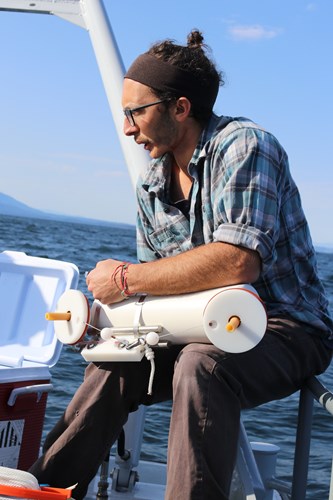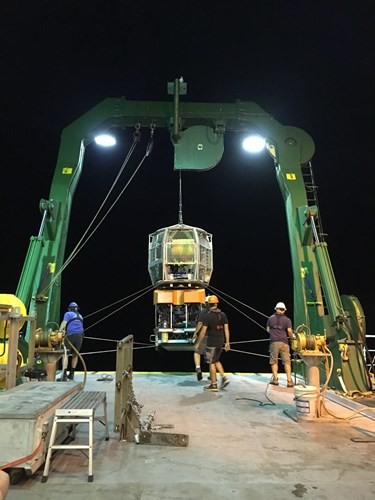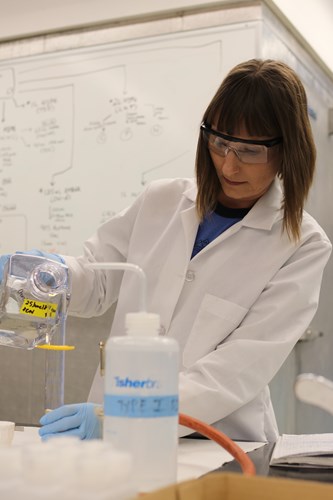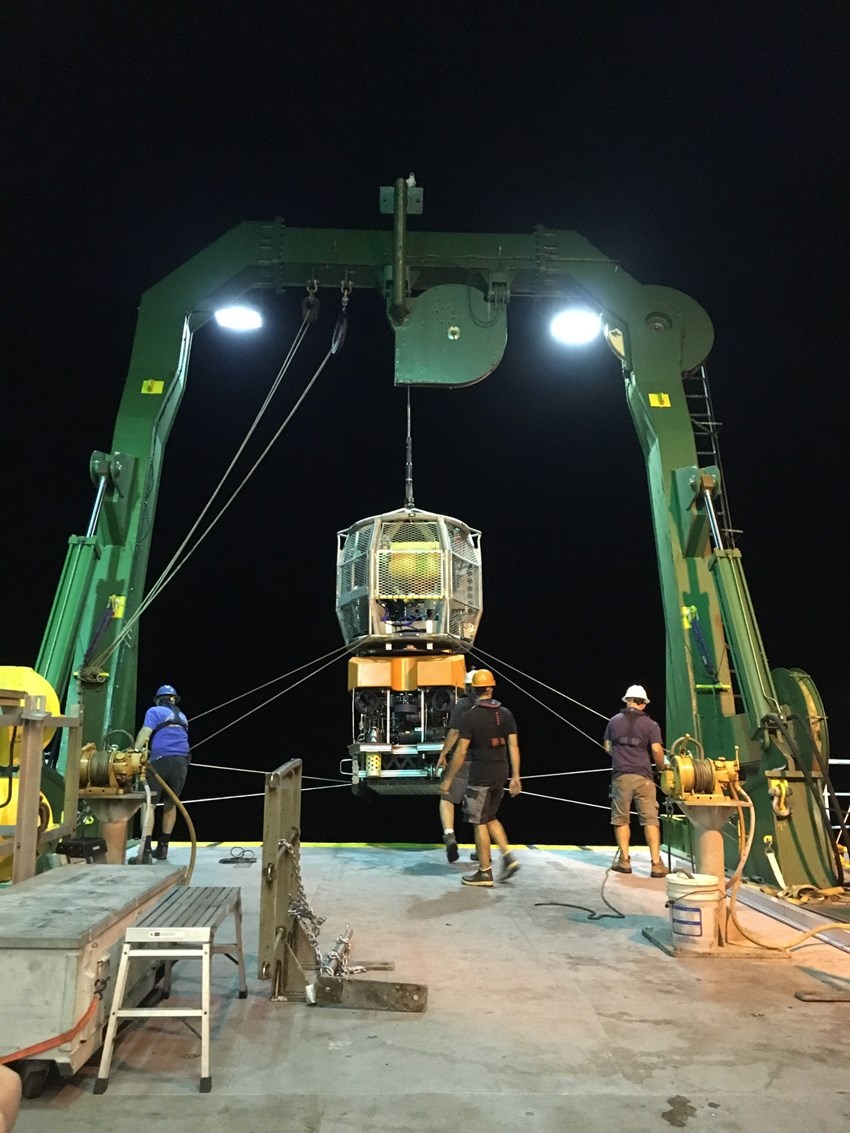Masters of Microbes: A Team of Scientists at the Flathead Lake Biological Station Brings Ocean Research Techniques to Flathead Lake
by Heather Fraley, Environmental Science and Natural Resource Journalism Intern
John Ranieri remembers standing in the back of a 200-foot-long ship one night and feeling a different kind of solitude than he ever had before. As the sea breeze brushed his face, he realized that if he fell off the ship, he would never be found. He was spending a month on the Pacific Ocean, on his first ever research cruise. There were no other ships for miles, and over 30 days the only land animal he saw was one forlorn bird.
Ranieri is a member of a research team based at the Flathead Lake Biological Station near Polson, Montana. He works for Associate Professor Matt Church, an oceanographer and aquatic scientist who studies microscopic life. Church came to the University of Montana’s Bio Station from the University of Hawaii two years ago.
The Church Lab for Microbial Biogeochemistry and Ecology is bringing knowledge learned on the open ocean to Flathead Lake.
Church is among the leading researchers in ocean microbial ecology. His work is unique because he runs an oceanography lab that also does work on lakes. Most aquatic scientists work either on lakes or on oceans, creating two distinct camps of people, with little crossover.
“Ironically many of the techniques or methodologies are directly transferable,” says Church.
Some people in Church’s lab have lake backgrounds and some have ocean backgrounds. They are finding that the “lake people” and the “ocean people” can learn a lot from each other.
Just as a ship in a bottle is a scaled-down version of a sea-going vessel, microbial research on the lake is somewhat like a scaled-down version of research on the ocean.
The lab’s ocean sampling sites can be over 3 miles deep, vastly outstripping Flathead Lake’s maximum depth of just under 400 feet. On the lake they use smaller boats, smaller research tools and far less cable.
One of the ocean research tools that the team is adapting for use in Flathead Lake will help them more efficiently collect water samples. The device, called a rosette, looks a little like a giant pack of dynamite. A bunch of different cylindrical water collection tubes are held around a circular frame. The computer in the device can be programmed to close each tube at different depths.
Why Study Microbes?
Church studies the things in the clear, cold water of Flathead Lake that can’t be seen by the naked eye, known as microbes. These include bacteria and single-celled organisms from several other taxonomic groups. The microscopic community in a lake is vital to how a lake functions as a whole, but it hasn’t been extensively studied in Flathead Lake.
Microbes are tiny but mighty. They are like invisible maintenance elves that keep the world running smoothly. They are found everywhere on the planet including under the earth’s crust, on human bodies and in the atmosphere. Microbes are biologically old, having been on earth for over three billion years. They can persist in dark, pressure-filled environments, can recycle nutrients and they form the very bottom of the food chain.
Microbes are responsible for making the earth a place that can sustain life, and ocean microbes produce half the oxygen in the atmosphere.
“We would not be here if it weren’t for microorganisms,” says Church.
John Ranieri, who is a research associate and functions as a jack of all trades for the Church lab, does much of the lake fieldwork. He says that people have historically viewed zooplankton as the bottom of the food chain, but microbes are even further down the rungs of the food chain ladder.

Lab Technician John Ranieri prepares a sampling bottle to drop to depth on the Flathead Lake Monitoring Program. Photo Heather Fraley
“Microbes are even smaller, and even less people care about them,” jokes Ranieri. “But the zooplankton are eating those microbes. “If we can understand what changes the microbial community, and what nutrients they’re able to recycle at different times of the year, then that is ultimately going to affect the zooplankton communities, and that’s going to affect the fish communities.”
Flathead Lake is a well-known recreational fishery, so anything affecting the fish is of broad interest to the residents of the area, as well as to agency managers and scientists.
The Church lab is looking at how the microbial communities in the lake work. To do this they are using genetic techniques similar to those commonly used in ocean research. They look at which microbes are present where in the lake, and how many there are at different depths as the seasons change, by analyzing the DNA they collect in their water samples.
Soon they plan to start using metagenomics. Where genetic techniques look at specific genes of an organism, genomics looks at the entire genetic profile of an organism – the compilation of all the genes – to decode what ecological functions that organism might be performing. Church’s graduate student Kate Evans will be helping with this project. She loves using math and computer modeling. She will also be working with a lot of long-term time series data.
Time Matters
One of the team’s goals is to start tracking changes in the lake’s microbial communities over time. They will add their genetic and genomic data to the long-term Flathead Lake Monitoring Program that has been going on since the late 70’s. Evans is looking forward to modeling some of the long-term data to find out what’s controlling certain patterns. “There are a lot of really rigorous math ways that you can get into it that are often untapped,” she says.
Long-term projects are particularly attractive to Church because they put new data into context and can generate future research questions. Church has been involved in another long-term monitoring project, the Hawaii Ocean Time-series (HOT) program, where he served as the principal investigator, and his lab continues to conduct research as part of a project called SCOPE (Simons Collaboration on Ocean Processes and Ecology) at a time-series field site located 62 miles north of the island of Oahu in Hawaii.
What does it take to be an ocean and lake researcher?
Being a part of Church’s lab is not for the faint of heart. All of the members are stress-tested on research adventures like ocean research cruises. Church calculates that he’s spent a combined one year of his life on the open ocean, and he even met his wife Holly on an ocean research cruise. His longest research cruise, 48 days, was in the Antarctic. “I encourage people who are working with me to go out to sea, and I think it’s sort of a once- in- a- life-time kind of opportunity,” he says.
Church encouraged John Ranieri to experience ocean research, and he has the perfect personality for it. Being around him gives the sense that not much fazes him. He possesses an important trait for surviving ocean cruises: a good sense of humor. One of his running jokes is to steal one decoration per holiday from a particularly holiday-minded coworker’s office door. (His office nameplate now sports a shiny green shamrock and sparkling red heart).
Every member of the lab also has jaw-dropping amounts of research experience at the cutting edge of their fields.
Emma Wear is a postdoctoral researcher in Church’s lab. Wear met Church at the University of Hawaii when she was working on her PhD and took his microbial oceanography summer class. When Church moved from Hawaii to the Flathead Lake Biological Station and advertised for postdocs, she immediately applied.
She just finished her first month-long ocean cruise with Church in June; funded by the Gordon and Betty Moore Foundation, a private foundation interested in biological conservation.
This most recent ocean cruise focused on the ecosystem at the very bottom of the ocean known as the abyssal sea floor. Other than surface fishing, this ecosystem is virtually undisturbed by human activity. It’s escaped dramatic alteration, because it’s so deep under the surface.
The goal of the research cruise was to catalogue the organisms present in the ecosystem before the start of some planned deep-sea mining. Wear catalogued manganese nodules. These are mysterious slow-forming growths of manganese and other metals packed together, that grow at the rate of millimeters per millions of years.
Wear says that the thrill of discovery was part of what made the cruise so alluring for her. She’s interested in how dissolved carbon like proteins and detritus from dead animals cycles in the water. Carbon cycling at the surface of the ocean is well-known because it’s all based on sunlight, but what’s less-known is what drives microbes in the deep ocean sediments where the sun doesn’t reach.
While she usually samples surface water, this time she was working with sea-floor sediments.
The particular area the crew reached is remote in distance as well as in depth. It took Church and Wear four days of continuous boat travel just to reach the sampling site.
“That’s why it’s a month-long cruise,” says Wear. “By the time you get out there, you might as well stay there for a while.”

The remotely operated vehicle is prepared for a sampling trip on the month-long ocean research cruise that Church and Wear went on. Photo by Emma Wear
Being on this ocean cruise presented some striking challenges for Wear.
For example, the frustrating part of sediment collection was that the sediments sometimes were too sandy to stay in the collection tube on the remotely-operated unmanned underwater vehicle.
Wear would be up at all hours collecting samples. Watching her precious sample fall out of the collection tube in the wee morning hours was frustrating “It’s less funny at three-o’clock in the morning,” she says.
Another challenge that took some getting used to on a long-term cruise was the lack of space to walk. She usually walks her dog every day. On the boat there was really nowhere to go.
She also missed the color green.
“You don’t see green things for a full month other than the salad bar,” she said. “Then eventually the salad bar starts rotting and goes away. It’s great being back here in the summer, because I get to see all the green stuff that I missed.”
She agrees that there are parallels between ocean and lake research, and that an ocean background can make her that much more qualified to study lakes.
She says that they are asking similar questions in both environments about microbial metabolism, and they are using some of the same techniques. Wear, who is an “ocean person,” will be involved in the genomics research on Flathead Lake, while she continues to do work on the ocean following the cruise.
Trista Vick-Majors is another postdoc in Church’s lab. She also met Church through his summer microbial oceanography class in Hawaii. She’s overcome motion sickness to go on a two-week ocean cruise, but as a “lake person” the majority of her background is in studying microbes in ice-covered Antarctic lakes.

Trista Vick-Majors works in the Flathead Lake Biological Station Research Lab. Photo Heather Fraley
During her PhD research, she was part of a crew that did some of the first sampling of sub-glacial lake water. Her team used a giant hot water drill to put a hole through the Antarctic ice sheet and drop their sampling gear 800 meters down to the water. Vick-Majors was among the first to definitively show that there were microbes in Antarctic sub-glacial lake water. “There are plenty of them,” she says with a smile as she pours liquid into a graduated cylinder in the bio station lab.
Vick-Majors is currently investigating if microbes are responsible for producing extra methane found in the water of Flathead Lake.
The lab’s theory is that certain microbes in the lake can separate methyl groups from organic compounds to produce extra methane. Church has done research on this phenomenon in the ocean, and now he’s finding it may apply in Flathead Lake as well. Vick-Majors is feeding lake microbes a compound called methylphosphonate and looking for production of methane.
Methane is thought to be produced exclusively by microbes growing without oxygen, but Flathead Lake is well-oxygenated. The possibility that methane is produced in well-oxygenated lake water is exciting. It opens up a whole new pathway of methane production.
Since methane is a powerful greenhouse gas, this research is important in the face of changing climate.
For John Ranieri, working for Matt Church has been a great experience. The ocean cruise made him feel like a real scientist straight off the Discovery Channel that he watched as a kid.
Part of the reason he came to the Flathead Lake Biological Station was to join a place full of opportunities for collaboration and innovation. His previous experience working on wildlife biology projects showed him how easy it can be to focus on one thing and not look at the other pieces of ecosystem. He enjoys the crossover between lake and ocean work.
“It’s cool how much overlap there is,” he says, “and how when you bring those two knowledge bases together, you can really understand a lot more about the lake in a faster time.”


